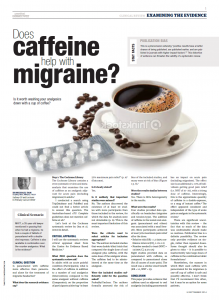 This article was published in Medical Observer.
This article was published in Medical Observer.
The article is also available on the Medical Observer website (may need registration).
Clinical scenario
Matt, a 35-year-old lawyer mentioned in passing that when he had a migraine, he took a couple of tablets of paracetamol with a double-shot espresso. Caffeine is also available in combination over-the-counter analgesics. What is the evidence?
Clinical question
Is paracetamol with caffeine more effective than paracetamol alone for the treatment of migraine headaches?
What does the research evidence say?
Step 1: The Cochrane Library
The Cochrane Library contains a 2012 systematic review and meta-analysis that examines the use of caffeine as an analgesic adjuvant for acute pain (including migraines) in adults. [1]
I conducted a search using TripDatabase and PubMed and could not find a better article to answer this question. The Australian-based eTG Complete guidelines does not mention caffeine at all. [2]
Let’s look at the Cochrane systematic review by Ona et al. (2012) in detail.
Critical appraisal
I will use the systematic reviews critical appraisal sheet from the Centre for Evidence Based Medicine. [3]
What PICO question does the systematic review ask?
In adults with an acute painful condition (Participants); what is the effect of caffeine in addition to a number of oral analgesics (Intervention); compared to the same analgesic without caffeine (Comparator); on the proportion of participants achieving “at least 50% maximum pain relief” (p. 4) [1] (Outcome).
Is it clearly stated?
Yes.
Is it unlikely that important studies were missed?
No. The authors discovered the existence of at least 20 studies with more participants than those included in the review, for which the data for analysis were not obtainable (p. 6). [1] This is the most important limitation of this review.
Were the criteria used to select articles for inclusion appropriate?
Yes. The authors included studies that were double-blind trials that compared the single dose of oral analgesic plus caffeine, with the same dose of the analgesic alone. The caffeine had to be administered at the same time as the analgesic.
Were the included studies sufficiently valid for the question asked?
Probably/Unclear. The authors formally assessed the risk of bias of the included studies, and many were at risk of bias (Figure 1, p. 8). [1]
Were the results similar between studies?
Yes. There is little heterogeneity in the results.
What were the results?
Four studies provided data specifically on headaches (migraine and tension-type). The addition of caffeine to the tested oral analgesic (paracetamol and others) was associated with a small benefit. More participants achieved at least 50% maximum pain relief after the dose:
- Relative risk (RR) = 1.1 (95% confidence interval [CI], 1.1 to 1.2)
- Number needed to treat (NNT) = 14 (95% CI, 9.5 to 25)
Eight studies provided data on paracetamol with caffeine, as compared to paracetamol alone (for all causes of acute pain). The result was a similar sized benefit (RR = 1.1, NNT = 15).
Conclusion
This paper provides evidence that caffeine used as adjuvant to oral analgesia (including paracetamol) has an impact on acute pain (including migraines). The effect size is an additional 5-10% of individuals getting good pain relief (i.e., NNT of 10-20), with a 100 mg dose of caffeine. Interestingly, this is the approximate quantity of caffeine in a double-espresso, or a mug of instant coffee. [4] The effect appeared consistent and independent of the type of acute pain or analgesic in the systematic review. [1]
There are significant uncertainties with this review – the fact that so much of the data was unobtainable should make us cautious. Publication bias is a definite possibility. The review only provides evidence on single, rather than repeated doses. Some thought should also be given to risks – it is possible to inadvertently take large doses of caffeine in the combination tablet formulations. [5]
Nonetheless, the manner in which Matt used caffeine with paracetamol for his migraines (a one-off cup of coffee) is safe and possibly effective. I don’t think that I’ll recommend this often, but it may be an option for some patients.
Stat Facts
Publication bias
This is a phenomenon whereby “positive results have a better chance of being published, are published earlier, and are published in journals with higher impact factors”. [6] This distortion of evidence can threaten the validity of a systematic review.
References
- Derry CJ, Derry S, Moore RA. Caffeine as an analgesic adjuvant for acute pain in adults. Cochrane Database of Systematic Reviews 2012, Issue 3. Art. No.: CD009281. DOI: 10.1002/14651858.CD009281.pub2
- Acute migraine attack (etg42 March 2014) [website]. eTG Complete. Last updated: 2014 Mar (Retrieved: 2014 Jul 21). http://etg.tg.com.au/ip/desktop/tgc/nrg/2142.htm
- Systematic Review: Are the results of the review valid [MS Word document]? Centre for Evidence Based Medicine, University of Oxford. Last updated: 2008 Oct 1 (Retrieved: 2014 Jul 21) http://www.cebm.net/critical-appraisal/
- Basic Report: 14210, Coffee, brewed, espresso, restaurant-prepared [website]. National Nutrient Database for Standard Reference, release 26, Agricultural Research Service, United States Department of Agriculture. Retrieved: 2014 Jul 21. http://ndb.nal.usda.gov/ndb/foods/show/4291?fg=&qlookup=espresso
- Paracetamol with caffeine (Panadol Extra) available over the counter from pharmacies [website]. NPS RADAR. 2010 Aug 1. http://www.nps.org.au/publications/health-professional/nps-radar/2010/august-2010/brief-item-paracetamol-with-caffeine
- Dubben H-H, Beck-Bornholdt H-P. Systematic review of publication bias in studies on publication bias. BMJ 2005;331. DOI: 10.1136/bmj.38478.497164.F7
